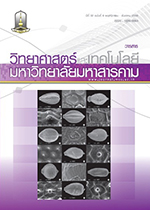ความไวต่อสารต้านจุลชีพของแบคทีเรียที่แยกได้จากถุงนํ้าเชื้อของกุ้งกุลาดำ (Penaeus monodon) ที่เก็บรักษาแบบแช่แข็ง
Main Article Content
Abstract
บทคัดย่อ
การศึกษาในครั้งนี้เป็นการศึกษาถึงความไวของแบคทีเรียที่แยกได้จากถุงนํ้าเชื้อกุ้งกุลาดำ (Penaeus monodon) ที่เก็บรักษาแบบแช่เข็งต่อสารต้านจุลชีพจำนวน 14 ชนิด ด้วยวิธี Disk diffusion method โดยแบคทีเรียที่แยกได้ดื้อต่อสารต้านจุลชีพแต่ละชนิดแตกต่างกัน โดย Pseudomonas aeruginosa เป็นแบคทีเรียที่ดื้อต่อสารต้านจุลชีพสูงที่สุด(85.71%) ในขณะที่ Alcaligenes xylosoxidans, Proteus mirabilis, Ochrobactrum anthropi, Microbacterium spp.และ Burkholderia cepacia เป็นแบคทีเรียที่ดื้อต่อสารต้านจุลชีพได้ค่อนข้างสูง โดยดื้อต่อยาต้านจุลชีพเท่ากับ 50.00%,50.00%, 50.00%, 57.14% และ 71.43% ตามลำดับ และ Kocuria varians เป็นแบคทีเรียที่ดื้อต่อสารต้านจุลชีพน้อยที่สุดคิดเป็น 85.71% เมื่อทำการศึกษาเกี่ยวกับความไวต่อยากลุ่มเบต้า-แลคแตม จำนวน 3 ชนิด คือ Penicillin, Ampicillinและ Imipenem พบว่าแบคทีเรียจำนวน 12 ชนิด คือ Bacillus cereus, B. megaterium, B. licheniformis, Staphylococcusepidermidis, P. mirabilis, P. aeruginosa, O. anthropi, A. xylosoxidans, A. faecalis, Micrococcus spp., Brevibacterium spp.และ Microbacterium spp. เป็นแบคทีเรียที่ดื้อต่อยากลุ่มเบต้า-แลคแตมได้มากกว่า 50.00% แต่พบว่าแบคทีเรียในกลุ่มนี้มีเพียง7 ชนิด ได้แก่ B. cereus, B. licheniformis, S. epidermidis, P. mirabilis, A. xylosoxidans, A. faecalis และ P. aeruginosa เท่านั้นที่สามารถผลิตเอนไซม์เบต้า-แลคตาเมส แสดงให้เห็นว่าการดื้อต่อสารต้านจุลชีพกลุ่มเบต้า-แลคแตมของแบคทีเรียที่แยกได้จากถุงนํ้าเชื้อกุ้งกุลาดำในการศึกษาครั้งนี้ไม่มีความสัมพันธ์กับการผลิตเอนไซม์ชนิดนี้ ดังนั้นการดื้อต่อสารต้านจุลชีพในกลุ่มเบต้า-แลคแตมของแบคทีเรียกลุ่มนี้ไม่ได้เกิดจากการผลิตเอนไซม์เบต้า-แลคตาเมสเพียงอย่างเดียว
คำสำคัญ: สารต้านจุลชีพ แบคทีเรีย กุ้งกุลาดำ (Penaeus monodon) การแช่แข็ง ถุงนํ้าเชื้อ เอนไซม์เบต้า-แลคตาเมส
Abstract
In this study, the susceptibility of bacteria isolated from black tiger shrimp (Penaeus monodon) spermatophore maintained in cryopreservation to 14 antimicrobial agents was examined using the disk diffusion method.P. aeruginosa showed the highest percentage of resistance (85.71%) to antimicrobial agents, while A. xylosoxidans, P. mirabilis, O. anthropi, Microbacterium spp. and B. cepacia displayed a high percentage of resistance: 50.00%, 50.00%, 50.00%, 57.14% and 71.43%, respectively, and K. varians exhibited the highest level of susceptibility (85.71%). Moreover, B. cereus, B. megaterium, B. licheniformis, S. epidermidis, P. mirabilis, P. aeruginosa, O. anthropi, A. xylosoxidans, A. faecalis, Micrococcus spp., Brevibacteriumspp. and Microbacterium spp. showed a percentage of resistance to β-lactams of more than 50.00%, and B. cereus,B. licheniformis, S. epidermidis, P. mirabilis, A. xylosoxidans, A. faecalis and P. aeruginosa were able to produceβ-lactamase. This investigation highlighted that the resistance to β-lactams of bacteria isolated from black tiger shrimpspermatophore was not related to β-lactamase production. Therefore, the incidence of β-lactams resistance of those bacteria did not only emerge from β-lactamase production.
Keywords : Antimicrobial agents; Bacteria; Black tiger shrimp (Penaeus monodon); Cryopreservation; Spermatophore; β-lactamase


